Sheikh Lotfollah Mosque Introduction
Sheikh Lotfollah mosque is a remarkable example of Persian architecture. This unique gem of Persian architectural history was built during the Safavid dynasty in the early 17th century (1603-1619) in Isfahan, Iran. Its beauty appeals to many tourists, from history to architectural enthusiasts. Here, you can explore the charm of Sheikh Lotfollah mosque, a treasure that beckons with timeless beauty and a rich history.
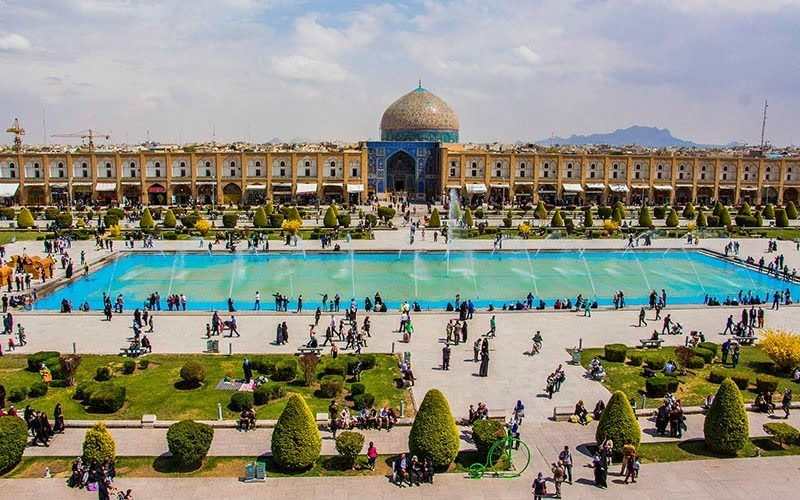
Sheikh Lotfollah mosque’s strategic location on the eastern side of Naqsh-e Jahan Square, a UNESCO World Heritage Site, is a central landmark in the city. Unlike traditional mosques, this one was built for private and courtly use, often by the royal family, making it a unique religious structure. Sheikh Lotfollah mosque’s single-dome design, devoid of minarets and courtyards, reveals the craftsmanship of the Safavid era.
History of Sheikh Lotfollah Mosque
Sheikh Loftollah mosque is an architectural marvel of the Safavid era, built under the decree of Shah Abbas I. The renowned architect, Mohammadreza Isfahani, elevated this masterpiece into an architectural marvel in Isfahan. Sheikh Lotfollah mosque’s construction was partly a tribute to Sheikh Lotfollah. He was a distinguished Islamic sheikh and the father-in-law of Shah Abbas I. His significant influence as a Shia sheikh and the ruler’s admiration for him prompted the commissioning of this splendid structure. Consequently, Shah Abbas I’s deep respect and affection for Sheikh Lotfollah drove him to ensure the sheikh’s presence in Isfahan by constructing this remarkable mosque.
Architecture of Sheikh Lotfollah Mosque
Sheikh Lotfollah mosque’s unique architectural attributes render it a unique destination. Noteworthy for the absence of minarets, It charms visitors with a fascinating combination of light and sound in its sacred halls. Ornate calligraphies and vibrant tilework design its interior, while its muqarnas grace the entrance and interiors. Each of these features combines harmoniously, turning this place into a grand and charming destination.
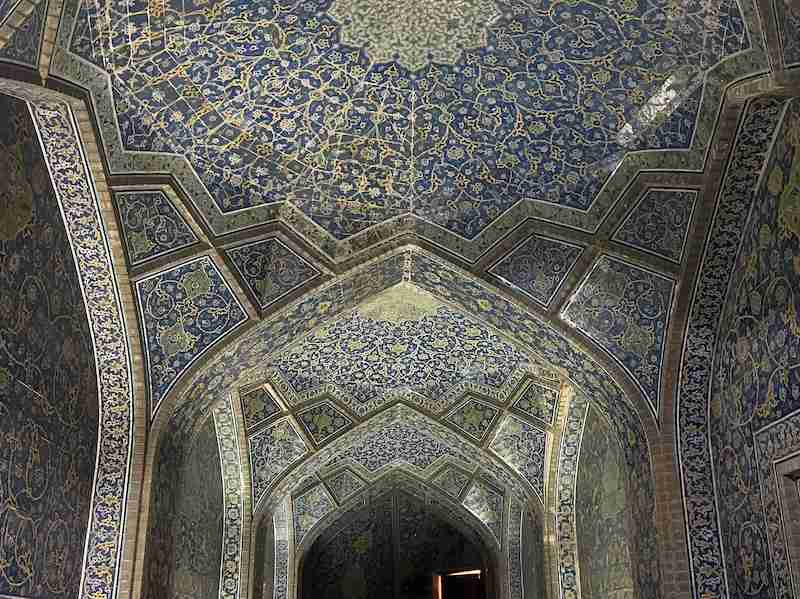
The Muqarnas of Sheikh Lotfollah Mosque
Muqarnas, a distinctive architectural element in Persian mosques, takes center stage in Sheikh Lotfollah mosque. Two remarkable Muqarnas installations, one at the entrance and another within the interior, offer a fascinating sight. Sheikh Lotfollah mosque’s rich decorations, designed with blue and yellow tiles, extend to these Muqarnas, where blue tiles emphasize their beauty. These architectural features serve both structural and decorative purposes, supporting the dome’s integrity while surprising visitors with their visually interesting design. Sheikh Lotfollah mosque, a wonderful structure from the Safavid dynasty, shows how Muqarnas, beyond their functional role, are celebrated for their aesthetically pleasing contribution to the mosque’s ambiance.

The Acoustics of Sheikh Lotfollah Mosque
Visitors to Sheikh Lotfollah mosque often are amazed by its remarkable acoustics. The mosque’s architecture and dome structure enhance its unique acoustic qualities. In particular, when standing in the central area of the dome, visitors can experience impressive sound reflection and amplification. This auditory phenomenon is heightened by the dome’s patterns and calligraphic inscriptions, designed to disperse and reflect sound. Evidently, those exploring this mosque have described hearing echoes and experiencing the amplification of even the softest whispers, creating an auditory experience. Given that, this acoustic feature is believed to have been intentionally designed to enhance the ambiance of religious ceremonies.
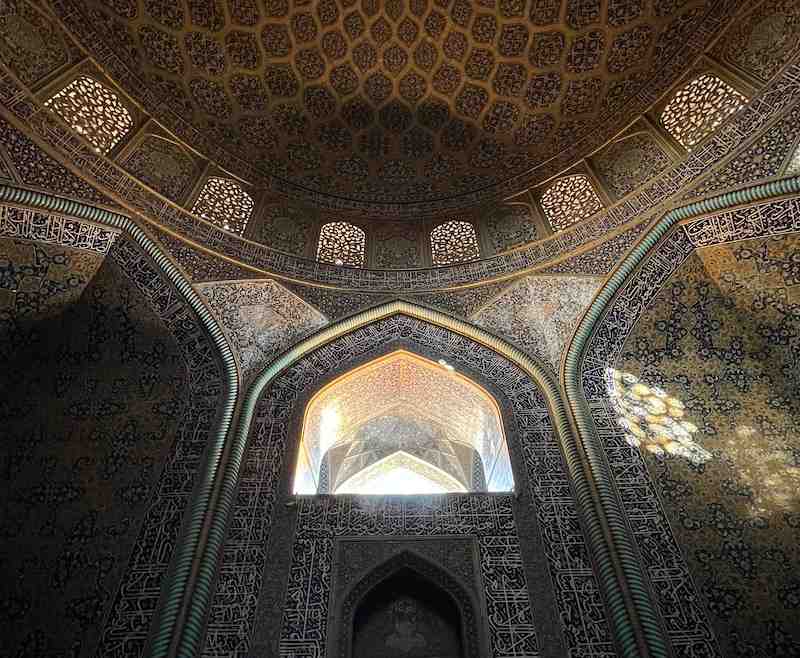
The Peacock on the Dome
The windows and tiles in Sheikh Lotfollah mosque are designed to create a visual spectacle, featuring an image of a peacock on the dome’s roof. In the windows, geometric patterns and floral motifs are incorporated. These designs permit specific rays of sunlight to filter through, diffusing and refracting the light, thus enhancing the overall visual effect.
The peacock adorning the dome of the mosque is an artistic wonder achieved through the harmonious interplay of window designs and tilework. In particular, skilled craftsmen arrange tiles and windows into geometric patterns and shapes, culminating in the distant illusion of a peacock. Subsequently, visitors to the mosque are enchanted as they look up at the dome. In addition, the peacock’s appearance evolves throughout the day, transforming with the sun’s changing angle. This dynamism creates a display of artistry, adding to the mosque’s allure.
Capturing the beauty of this peacock motif in photographs proves challenging, aligning with our aesthetic standards. Consequently, we’ve chosen not to display images. We extend an inviting embrace, urging you to experience this feature in person.
The Main Prayer Hall
The main prayer hall within Sheikh Lotfollah mosque shows its splendor and artistry. In detail, measuring 19 meters on each side, it transforms from a square to an octagon as it rises, ultimately assuming a circular shape, reflecting architectural roots in the Sassanid empire. Given that, when you gaze at the mosque’s ceiling, you’ll discover eight squinches supporting the dome. These are decorated with muqarnas featuring turquoise decorations along the edges. Seven-colored tiles design the lower sections, while mosaic tiles grace the upper portions. Calligraphic inscriptions in Nastaliq and Naskh scripts complete this artistic display.
Enigma of Minarets
An aspect that immediately captures attention within Sheikh Lotfollah mosque is its lack of a minaret. This unique characteristic sets this mosque apart from its Islamic counterparts since the minaret traditionally plays a pivotal role in mosque architecture.
Before Islam, minarets served as leading lights, guiding travelers from above and serving as distant city markers. Post-Islam, they gained significance as the call to prayer’s worship time. The clear absence of a minaret in this mosque highlights its specialized purpose. This mosque was never intended for public worship; instead, it was exclusively reserved for the royal court. They relied on alternative means for prayer call times.
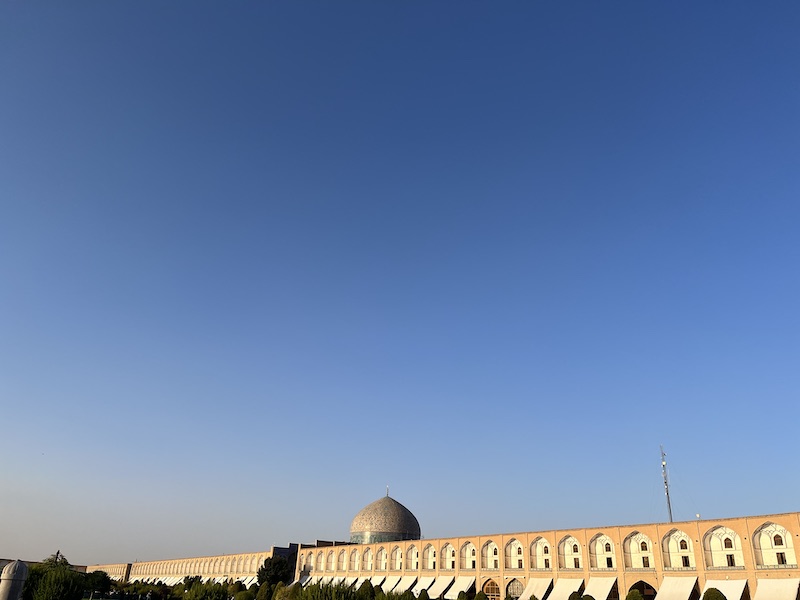
Various narratives surround the absence of a minaret in Sheikh Lotfollah mosque. In ancient Iran, the dome symbolized femininity, while the minaret represented masculinity. As the lore goes, architects tailored this masterpiece with a distinct focus on the female domain. Another theory suggests it was initially a Heram, not a mosque. However, it is essential to note that these narratives remain unverified.
The Tilework Mystery
When you step into the main prayer hall of Sheikh Lotfollah Mosque, you’ll immediately notice the striking blue mihrab before you. As your eyes adjust to the subdued ambiance, they naturally rise. After that, they fixate on the dome and the floral patterns decorating it. Then, you direct your gaze toward the dome’s center and tilt your head to embrace the interior light. Simultaneously, your feet meet the beautifully arranged blue tiles beneath you. It is akin to an architectural riddle, one that challenges your belief that such a masterpiece could be of human creation. The blue tiles on the floor represent the expanse of the sky, while the Khaki tiles gracing the dome evoke the solidity of the earth. This combination of elements shows the skill of the architect and the mosque’s meaning, making a space that goes beyond what humans can normally do.
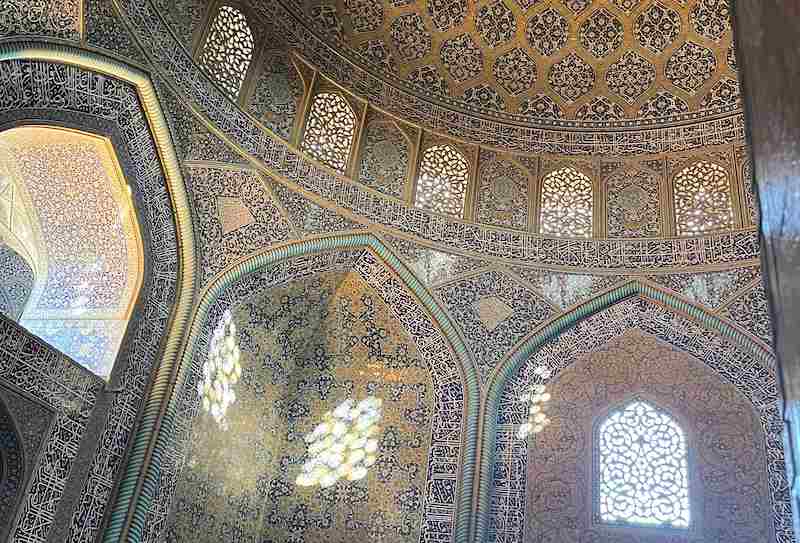
Your Upward Gaze
The enchantment of Sheikh Lotfollah mosque lies in its dome, designed with flower motifs, each varying in size. These flowers are not just artistic decorations but symbols, speaking of life’s transience and beauty within the natural world. They are a road to divine creation and a gentle reminder of the fleeting nature of earthly existence. Furthermore, as you gaze upward, you’ll notice the flowers gradually changing in size, like a floral symphony that guides your eyes toward the dome’s center. Here, you’ll feel as though your head is among a blossoming garden, and your feet are walking upon the sky-blue tiles resembling the boundless sky.
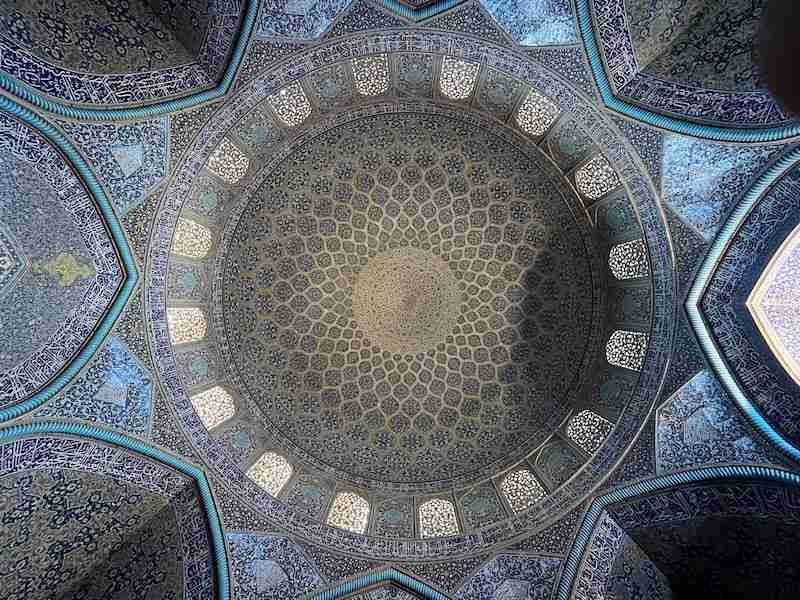
Sheikh Lotfollah Mosque’s dome is not merely an architectural miracle; it is a doorway to a world where the divine and the transient merge, an invitation to immerse yourself in a realm of beauty and contemplation. Therefore, a journey to this mystical site is an odyssey of the soul, where art, symbolism, and architecture intertwine to create an unforgettable experience.
Play of Light and Shadow
The precise geometric patterns of the windows within Sheikh Lotfollah mosque conspire to create a play of light and shadow. As daylight filters through, a radiant spectacle unfolds. A mosaic of tiles, each etched with verses from the Quran, designs the mosque’s walls. Nonetheless, what truly enchants visitors is the dance of light and shadow that these verses partake in. With the sun’s graceful arc across the sky, a tale emerges within the mosque’s walls. As the sun’s angle shifts, it caresses different verses on the walls, spotlighting one at a time. Therefore, it is as if the mosque itself becomes a storyteller, revealing its sacred verses throughout the day. This interplay of illumination and obscurity turns this mosque into a storybook of spiritual reflection. A visit to this remarkable place is an invitation to be part of a radiant narrative.

Contrasting Shiekh Lotfollah Mosque with Other Mosques
Among the grand tapestry of the world’s mosques, Sheikh Lotfollah mosque emerges as a unique gem. Its allure lies in the fusion of mathematics, geometry, and architectural genius. Unlike any other mosque worldwide, Sheikh Lotfollah mosque takes you on a journey of precision. Every tile and every window finds its place with utmost accuracy. It is a place where numbers and design harmonize, creating an atmosphere unlike any other.
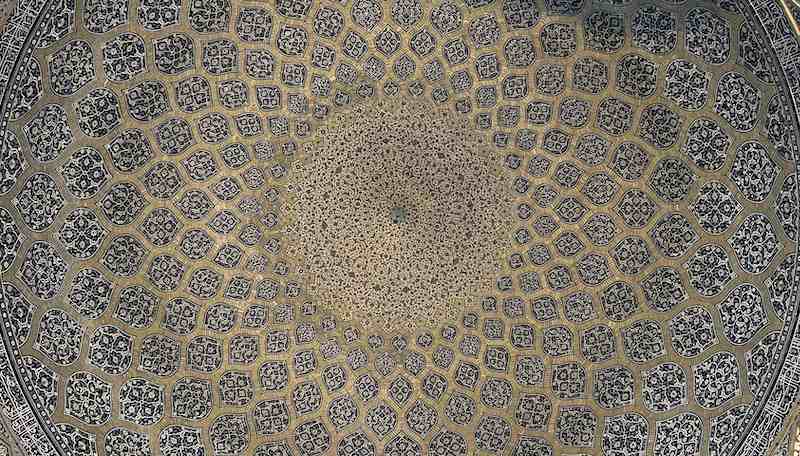
In Sheikh Lotfollah mosque the Quran’s concepts and prophetic wisdom merge with its very structure. Consequently, a web of Abjad letter calculations reveals the number 9 or its multiples. This adds a layer of mystique and depth to your journey. For example, the 32 flowers designing the dome, a poetic dance with the Quran’s 32nd Surah, Surah Sajdah, echoes the number 9. You can explore this relationship through various aspects, including the dominant color, which is Khaki or orange in Arabic. It also involves examining the number of internal inscriptions, multi-pointed stars, and the words related to this building, such as Quran and human.
Nearby Attractions to Sheikh Lotfollah Mosque
When you step into the world of Sheikh Lotfollah mosque, you open the door to an architectural marvel. But in Isfahan, Iran, the journey doesn’t end here; it is just the beginning.
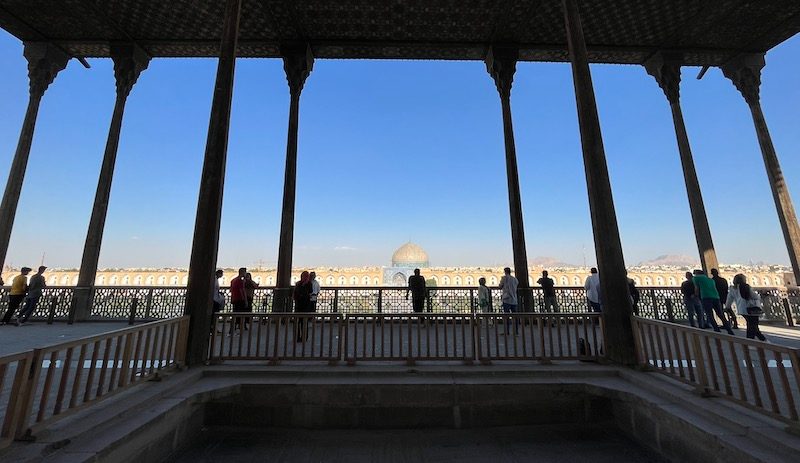
Shah mosque (Imam mosque) is a masterpiece located in Naqsh-e Jahan Square. Its splendid blue-tiled domes and mosaics are a sight to behold. Meanwhile, Ali Qapu Palace is just a stone’s throw away. This 16th-century gem boasts grand entrances, balconies, and exquisitely decorated interiors. Besides, Naqsh-e Jahan Square is a UNESCO World Heritage Site. It stands as one of the world’s largest city squares, encircled by landmarks, a hub of historical and cultural significance.
The Best Time to Visit Sheikh Lotfollah Mosque
The ideal time to visit Sheikh Lotfollah mosque is spring and fall. The weather during these periods is mild and comfortable, making outdoor exploration a delightful experience. Spring offers a lush landscape and pleasant temperatures, creating an pleasing atmosphere for your visit. The blooming flowers in the nearby gardens add to the mosque’s charm. Meanwhile, fall paints Isfahan in warm, earthy tones, making it an excellent time to explore the mosque and its surroundings. The weather is still enjoyable, and you can avoid the summer heat.
Moreover, aim to visit Sheikh Lotfollah mosque in the early morning or late afternoon to avoid crowds and capture the interplay of sunlight and shadow on its tilework. These times provide the perfect backdrop for memorable photographs. While both spring and fall offer a fantastic ambiance, plan your visit during weekdays to avoid weekend crowds.
A Guide to Visit Sheikh Lotfollah Mosque
Sheikh Lotfollah mosque is a blend of mathematics, artistry, and architectural enigmas. We recommend taking your time to explore it personally, rather than rushing. Each inscription, every window, the dome, and the play of light deserves your full attention. Let the mosque communicate with you through its light and wall inscriptions, embracing every moment in its serene ambiance.

Words Fall Short
Writing about Sheikh Lotfollah Mosque is no easy task. This living architectural marvel evolves over time, still revealing new facts. It pulsates with life. Grand in structure, it demands equally grand words, which continue to elude us.
The past whispers in the delicate patterns of tiles. The soul can touch the heavens in the curve of the dome, symbolizing femininity. Mathematical and geometric elements create a harmonious dance. As you enter, it is like stepping through an Alice mirror into a wonderland filled with art, architecture, music, and dance. The mosque’s central area becomes a confessional for your secrets. It is a reminder of the balance between the divine and the earthly. As the sun sets and shadows stretch across the tiles, you find clarity. It is as if the mosque tells you a story through light, revealing verses one by one. You realize that Sheikh Lotfollah Mosque is more than history or architecture; it reflects your journey. Like the mosque, you have transformed physically and emotionally, touched by the world in countless ways.
It was Mohammadreza Isfahani who built this masterpiece, a name and nothing more. It makes you ponder the recognition we seek and what it truly means to have a legacy. Sheikh Lotfollah Mosque invites you to explore the secrets it guards, here lies a transcendent experience awaiting you.

